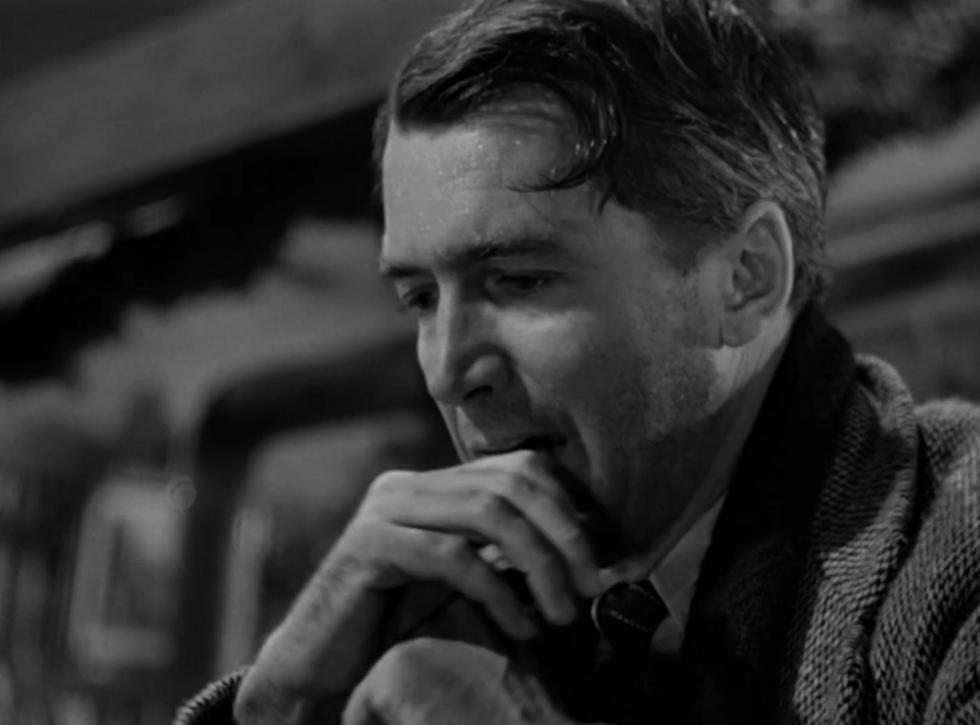1The movie is based on 'The Greatest Gift,' a short story by Philip Van Doren Stern.
 RKO Pictures//Getty Images
RKO Pictures//Getty ImagesPhilip Van Doren Stern originally started writing The Greatest Gift in 1939, but he had no luck publishing it at first.
2'It's a Wonderful Life' started out as a Christmas card.
 Getty Images
Getty ImagesAfter failing to find a publisher, Stern decided to print his story as a 21-page Christmas card that he sent to 200 of his friends in 1943. An RKO Pictures producer saw the "card" and convinced the studio to buy the rights to the story, which were eventually sold to Frank Capra's production company, Liberty Films.
Stern's short story was also eventually published as a book in 1944—and Stern also sold the story to Good Housekeeping, which published it in its January 1945 issue under the title "The Man Who Was Never Born."
Advertisement - Continue Reading Below
3Cary Grant was originally slated to play George Bailey.
 Getty Images
Getty ImagesAfter RKO Pictures sold the movie rights to Frank Capra's company, Capra decided to replace Cary Grant with James Stewart in the lead role. However, you may still see Grant on television around the holidays—he went on to appear in The Bishop's Wife.
4At first, James Stewart was afraid he wasn't up for filming a movie so soon after World War II.
 Hulton Archive//Getty Images
Hulton Archive//Getty ImagesLionel Barrymore (who played Mr. Potter in the movie) convinced Stewart to be in it. Stewart was also nervous about the phone kiss scene, his first on-screen kiss since returning from war.
Advertisement - Continue Reading Below
5The movie was shot in the summer of 1946 during a heat wave.
 Paramount
ParamountLook closely—you can see Stewart sweating in some of those snowy scenes. Ah, the magic of Hollywood.
6 A new type of artificial snow was engineered just for the movie.
 Paramount
ParamountPrior to It's a Wonderful Life, most movie productions used cornflakes painted white as "snow." However, Capra found this special effect to be too noisy, so he had the special effects department mix foamite (a fire-fighting chemical) with sugar and water. A whopping 6,000 gallons of this new "chemical snow" transformed the California set into a winter wonderland.
Advertisement - Continue Reading Below
7Uncle Billy wasn't supposed to yell after leaving George's house drunk.
 Paramount
ParamountAfter leaving the house, it sounds like Uncle Billy stumbles into trash cans and we hear him yell, "I'm alright, I'm alright." This wasn't a line in the script—it was a crew member who accidentally dropped equipment during filming and Capra decided to keep it. The crew member even got a $10 bonus for his off-screen appearance as "Uncle Billy."
8This was Donna Reed's first starring role.
 Archive Photos//Getty Images
Archive Photos//Getty ImagesShe would, of course, go on to become arguably the world's most famous TV housewife, thanks to The Donna Reed Show.
Advertisement - Continue Reading Below
9Reed really broke a window on the Granville House.
 Paramount
ParamountWhile a stuntman was standing by to throw a rock at the window, Reed broke it herself on the first try (which could apparently be attributed to her high school baseball days).
10Bedford Falls was one of the most elaborate sets ever built at the time.
 Paramount
ParamountIt's a Wonderful Life had a big budget for the time ($3.7 million), so it's no wonder that the crew put a lot of time and effort into constructing the town of Bedford Falls. The set took two months to build and included 75 buildings stretched out over four acres in Encino, California.
Advertisement - Continue Reading Below
11Seneca Falls, NY claims to be the inspiration for Bedford Falls.
 Paramount
ParamountWhile the fictional town's name combines those of Bedford Hills in New York's Westchester County and Seneca Falls in New York's Finger Lakes region, the latter claims to be the real deal. Seneca Falls even has a website, called TheRealBefordFalls.com, which is dedicated to pointing out all of the similarities between the two towns.
12You can visit an 'It's a Wonderful Life' museum.
 Paramount
ParamountYou guessed it—it's located in Seneca Falls. The town is also home to an annual It's a Wonderful Life festival. Plus, you can run in a movie-themed 5K and enjoy an annual festival each winter.
Advertisement - Continue Reading Below
13The movie struggled at the Academy Awards.
 Paramount
ParamountWhile It's a Wonderful Life didn't win any of the five major Oscars it was nominated for, it did take home a trophy. The RKO Effects Department received a Technical Achievement Award from the Academy of Motion Picture Arts and Sciences.
14The gym floor that opens to reveal a pool actually exists.
 Paramount
Paramount Advertisement - Continue Reading Below
15Capra didn't think it would become a Christmas film—let alone a Christmas classic.
 Archive Photos//Getty Images
Archive Photos//Getty Images"The film has a life of its own now and I can look at it like I had nothing to do with it," Capra once said, according to Mental Floss. "I'm like a parent whose kid grows up to be president. I'm proud… but it's the kid who did the work. I didn't even think of it as a Christmas story when I first ran across it. I just liked the idea."
16Carl Switzer (a.k.a. Alfalfa from 'The Little Rascals') played Freddie Othello.
 Paramount
ParamountSwitzer played the character who pushes the button that opens the gym floor to reveal the pool—but he is uncredited in the movie.
Advertisement - Continue Reading Below
17The rousing tune at the end of the movie was changed.
 Paramount
ParamountThe original final scene had the cast singing "Ode to Joy" instead of "Auld Lang Syne."
18Frank Capra had multiple jobs on the film.
 John Kobal Foundation//Getty Images
John Kobal Foundation//Getty ImagesNot only did Capra direct this film, but he also was a producer and one of the screenwriters. Additionally, his production company, Liberty Films, funded the movie.
Advertisement - Continue Reading Below
19The film didn't do well at the box office—it even put Capra into debt.
 RKO Pictures//Getty Images
RKO Pictures//Getty ImagesReceiving mixed reviews, It's a Wonderful Life only made back $3.3 of its $3.7 million budget at first. It placed 26th in box office sales for all films released in 1947—right ahead of Miracle On 34th Street.
20But it rose to popularity on TV in the late 1970s.
 Archive Photos//Getty Images
Archive Photos//Getty ImagesWhen It's a Wonderful Life's copyright lapsed in 1974, it became available royalty-free to any station that wanted to air it until 1994. Of course, thanks to repeated airings throughout the '80s, it's now a Christmas classic that's guaranteed to make an appearance on our television screens each holiday season.
Advertisement - Continue Reading Below
Advertisement - Continue Reading Below
Advertisement - Continue Reading Below
































